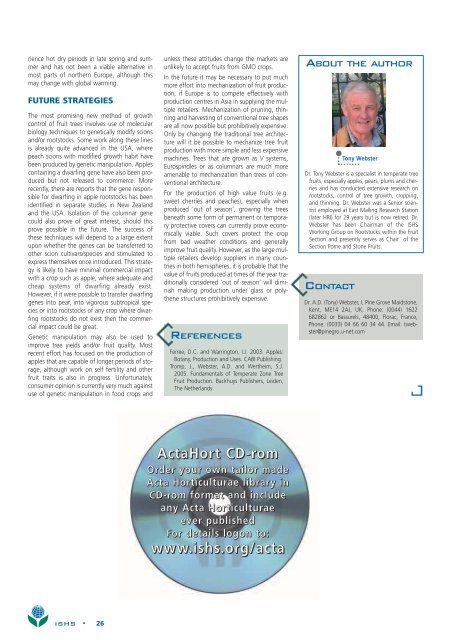Acta Horticulturae
Acta Horticulturae
Acta Horticulturae
You also want an ePaper? Increase the reach of your titles
YUMPU automatically turns print PDFs into web optimized ePapers that Google loves.
ience hot dry periods in late spring and summer<br />
and has not been a viable alternative in<br />
most parts of northern Europe, although this<br />
may change with global warming.<br />
FUTURE STRATEGIES<br />
The most promising new method of growth<br />
control of fruit trees involves use of molecular<br />
biology techniques to genetically modify scions<br />
and/or rootstocks. Some work along these lines<br />
is already quite advanced in the USA, where<br />
peach scions with modified growth habit have<br />
been produced by genetic manipulation. Apples<br />
containing a dwarfing gene have also been produced<br />
but not released to commerce. More<br />
recently, there are reports that the gene responsible<br />
for dwarfing in apple rootstocks has been<br />
identified in separate studies in New Zealand<br />
and the USA. Isolation of the columnar gene<br />
could also prove of great interest, should this<br />
prove possible in the future. The success of<br />
these techniques will depend to a large extent<br />
upon whether the genes can be transferred to<br />
other scion cultivars/species and stimulated to<br />
express themselves once introduced. This strategy<br />
is likely to have minimal commercial impact<br />
with a crop such as apple, where adequate and<br />
cheap systems of dwarfing already exist.<br />
However, if it were possible to transfer dwarfing<br />
genes into pear, into vigorous subtropical species<br />
or into rootstocks of any crop where dwarfing<br />
rootstocks do not exist then the commercial<br />
impact could be great.<br />
Genetic manipulation may also be used to<br />
improve tree yields and/or fruit quality. Most<br />
recent effort has focused on the production of<br />
apples that are capable of longer periods of storage,<br />
although work on self fertility and other<br />
fruit traits is also in progress. Unfortunately,<br />
consumer opinion is currently very much against<br />
use of genetic manipulation in food crops and<br />
unless these attitudes change the markets are<br />
unlikely to accept fruits from GMO crops.<br />
In the future it may be necessary to put much<br />
more effort into mechanization of fruit production,<br />
if Europe is to compete effectively with<br />
production centres in Asia in supplying the multiple<br />
retailers. Mechanization of pruning, thinning<br />
and harvesting of conventional tree shapes<br />
are all now possible but prohibitively expensive.<br />
Only by changing the traditional tree architecture<br />
will it be possible to mechanize tree fruit<br />
production with more simple and less expensive<br />
machines. Trees that are grown as V systems,<br />
Eurospindles or as columnars are much more<br />
amenable to mechanization than trees of conventional<br />
architecture.<br />
For the production of high value fruits (e.g.<br />
sweet cherries and peaches), especially when<br />
produced ‘out of season’, growing the trees<br />
beneath some form of permanent or temporary<br />
protective covers can currently prove economically<br />
viable. Such covers protect the crop<br />
from bad weather conditions and generally<br />
improve fruit quality. However, as the large multiple<br />
retailers develop suppliers in many countries<br />
in both hemispheres, it is probable that the<br />
value of fruits produced at times of the year traditionally<br />
considered ‘out of season’ will diminish<br />
making production under glass or polythene<br />
structures prohibitively expensive.<br />
REFERENCES<br />
Ferree, D.C. and Warrington, I.J. 2003. Apples:<br />
Botany, Production and Uses. CABI Publishing.<br />
Tromp, J., Webster, A.D. and Wertheim, S.J.<br />
2005. Fundamentals of Temperate Zone Tree<br />
Fruit Production. Backhuys Publishers, Leiden,<br />
The Netherlands.<br />
ABOUT THE AUTHOR<br />
Tony Webster<br />
Dr. Tony Webster is a specialist in temperate tree<br />
fruits, especially apples, pears, plums and cherries<br />
and has conducted extensive research on<br />
rootstocks, control of tree growth, cropping,<br />
and thinning. Dr. Webster was a Senior scientist<br />
employed at East Malling Research Station<br />
(later HRI) for 29 years but is now retired. Dr.<br />
Webster has been Chairman of the ISHS<br />
Working Group on Rootstocks within the Fruit<br />
Section and presently serves as Chair of the<br />
Section Pome and Stone Fruits.<br />
CONTACT<br />
Dr. A.D. (Tony) Webster, I, Pine Grove Maidstone,<br />
Kent, ME14 2AJ, UK, Phone: (0044) 1622<br />
682862 or Bassurels, 48400, Florac, France,<br />
Phone: (0033) 04 66 60 34 44. Email: twebster@pinegro.u-net.com<br />
<strong>Acta</strong>Hort CD-rom<br />
Order your own tailor made<br />
<strong>Acta</strong> <strong>Horticulturae</strong> library in<br />
CD-rom format and include<br />
any <strong>Acta</strong> <strong>Horticulturae</strong><br />
ever published<br />
For details logon to:<br />
www.ishs.org/acta<br />
ISHS • 26
















